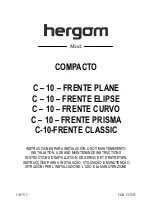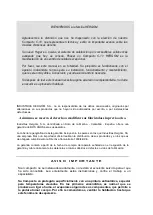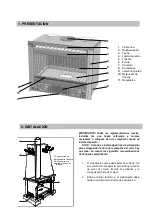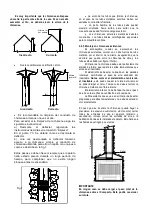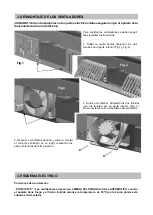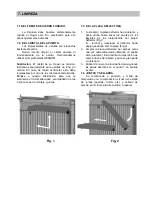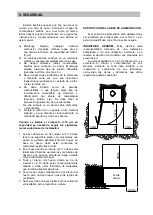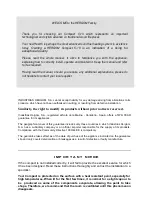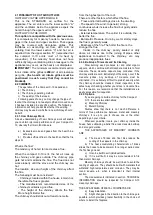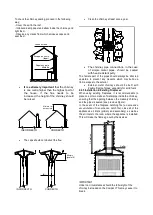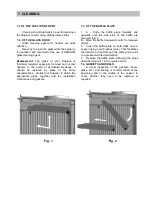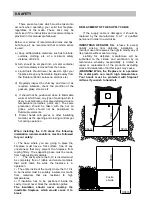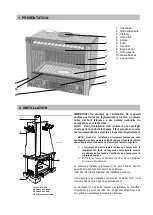
2.1 POSSIBILITY OF HOT AIR OUTFLOW.
OUTFLOW VIA THE UPPER GRILLE
This is the STANDARD air outflow for the
appliance. The air enters via the lower section “A”
and the ventilator inside the appliance expels the
hot air through the upper section “B”.
OUTFLOW VIA THE HOOD
This option is compatible with the previous one.
It is compulsory for masonry hoods to have some
gaps in the lower and upper sections. These gaps
may be covered with decorative grilles. This
facilitates an ascending air flow, with cold air
entering from the lower section “C” and hot air is
expelled from the upper section “D” (
remember that
the compact C-10 emits most of its heat by
convection
). If the masonry hood does not have
sufficiently large ventilation grilles, breakages to the
appliance may occur, as the heat is not dissipated.
IMPORTANT
! The minimum recommended section
for air intake of the grilles is
200
cm
²
of air clearance
per grille.
(the hood’s air intake grilles must be
positioned in such a way that they cannot be
blocked).
2.2
CHIMNEYS.
The operation of the Compact C-10 depends on:
a) The chimney.
b) The chimney operating method.
c) The quality of the fuel used.
Following years of use, you may change the type of
fuel but the chimney is not easily modified or moved once
it has been installed in a specific position. The following
information will help you decide whether the existing
chimney may be used or whether a new chimney should
be built.
2.2.1. How Chimneys Work
A basic understanding of how chimneys work will enable
you to obtain improved performance of your Compact C-
10, whereby their main functions are.
a) Evacuate smoke and gases from the hearth in a
safe way.
b) Provide sufficient flue in the hearth so that the fire
stays lit.
What is the flue?
The tendency of hot air to rise creates a flue.
When the compact C-10 is lit, the hot air rises up
the chimney and goes outside. The chimney pipe
gets hot and maintains the flue. The flue does not
work properly until the stove and the chimney are
hot.
The location, size and height of the chimney affect
the flue.
The following must be considered:
- Chimneys located within the house remain hot;
therefore the flue is greater.
-
The manufacturer’s recommended size of the
chimney maintains a good flue.
- The height of the chimney affects the flue:
More height, Better flue.
The chimney should stick out at least one metre
from the highest part of the roof.
There are other factors which affect the flue:
-
Trees and/or tall buildings close to the dwelling.
- The speed of the wind. In general, strong,
continuous winds increase the flue; but gusty winds
reduce the flue.
- External temperature. The colder it is outside, the
better the flue.
- Barometric Pressure. On rainy, wet or stormy days,
the flue is generally weak.
- Briskness of the fire. The hotter the fire is, the
stronger the flue.
Cracks in the chimney, poorly sealed or dirty
doors, air intakes due to the joining of pipes, other
appliances connected to the chimney, etc. may
produce inappropriate flues.
2.2.2. Build-up of Creosote and its Cleaning
Slow burning wood produces tar and other organic
vapours, which combine with atmosphere moisture to form
creosote. These creosote vapours may condense if the
chimney walls are cold. Extremely hot fires may occur if the
creosote ignites. Any build-up of creosote must be
eliminated. It is extremely difficult to predict exactly when
the chimney should be cleaned. Visual inspection is the
safest way of checking whether your stove is creosote free.
For this reason, we recommend that the installations are
easily accessible for inspection.
2.2.3. Options.
If you are going to build a chimney for the Compact
C-10, there are two alternatives:
a) Masonry Chimney.
b) Metal Chimney
Studies show that there is not much difference in
terms of flue performance between metal and masonry
chimneys. It is up to you to choose one or the other,
depending on your criteria.
Whenever possible, locate your chimney inside the
house, hence obtaining a better flue, less creosote build-up
and a longer duration.
THE ADVANTAGES OF MASONRY CHIMNEYS
ARE:
a) The mass of bricks and floor tiles reduce the
cooling of the vapours in the chimney.
b) The heat accumulating characteristic of bricks
allows the house to be kept warm for a longer period once
the fire has gone out.
c) It can be built to suit individual taste.
d) If it is well built, it may be more resistant to fire
than metal chimneys.
Masonry chimneys should be well lined to avoid the
cooling of vapours. They should be built with materials that
withstand high temperatures and corrosion. They may be
round, square, etc.; what is important is their internal
section.
The measurements indicated in section TECHNICAL
INFORMATION should be respected for Compact C-10
masonry chimneys.
THE ADVANTAGES OF METAL CHIMNEYS ARE:
a) Easy installation.
b) Slight changes in the direction to the chimney are
possible, which provides greater flexibility in the choice of
where to install the fireplace.

